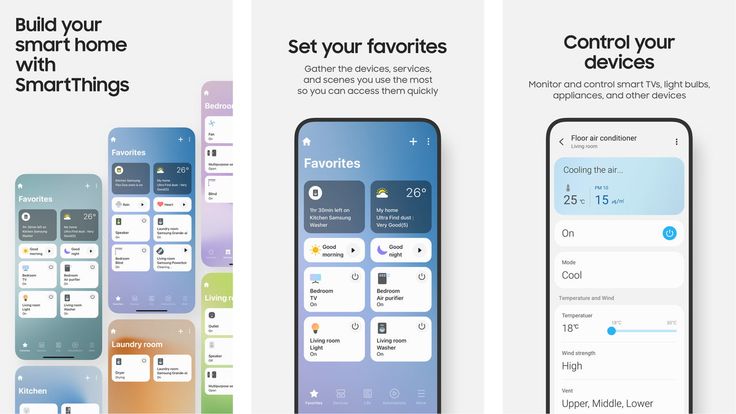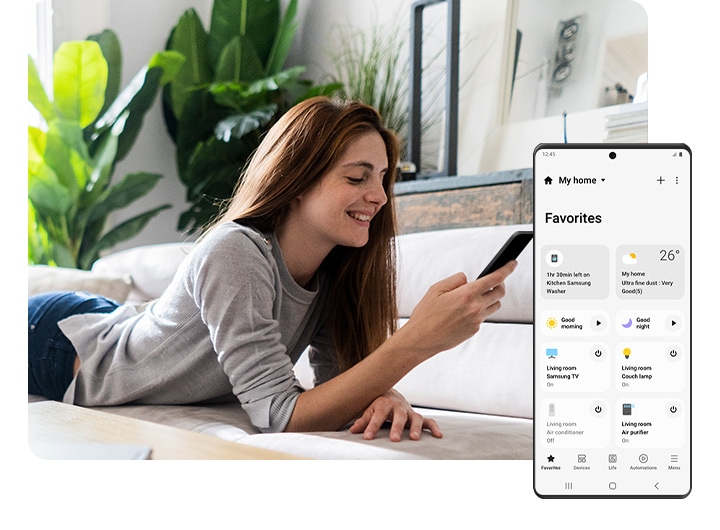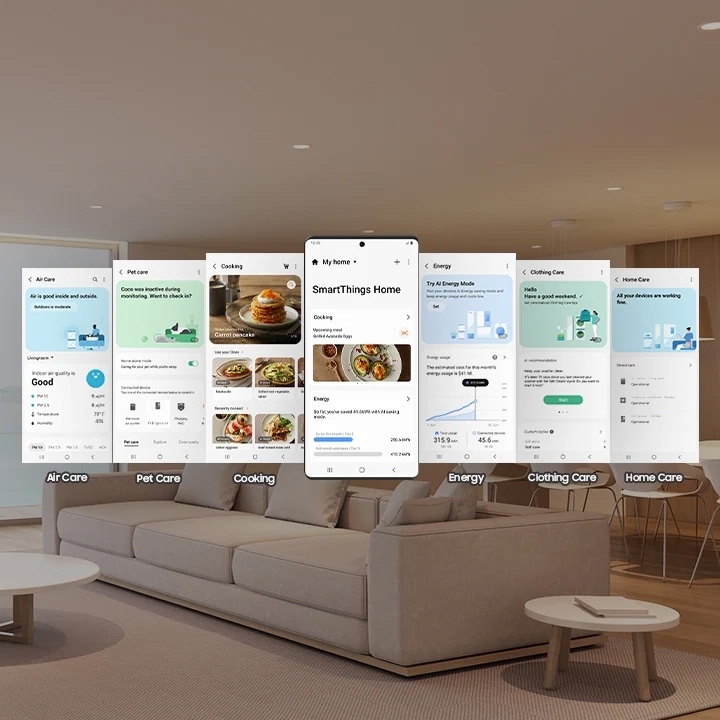SmartThings Samsung app stands at the forefront of home automation, seamlessly integrating various smart devices into one cohesive platform. With its extensive features, this app transforms ordinary living spaces into intelligent environments, allowing users to control everything from lighting to security systems with just a few taps.
Designed for compatibility with a vast array of devices, SmartThings not only simplifies managing home technology but also enhances daily life through innovative automation. This overview will guide you through its features, setup, and unique use cases that showcase its potential.
Features of the SmartThings Samsung App

The SmartThings Samsung app stands out in the realm of smart home applications due to its seamless integration, user-friendly interface, and extensive compatibility with a wide range of devices. This application allows users to control and monitor their smart home products from a single, consolidated platform, making it an essential tool for modern homes. With features tailored to enhance convenience and efficiency, the SmartThings app elevates the smart home experience.
One of the primary advantages of the SmartThings app is its ability to connect and control a vast array of smart devices, enabling users to create a cohesive ecosystem within their homes. This functionality is supported by a well-designed automation feature that allows for customized routines and schedules. Through automation, users can set their devices to perform specific actions based on triggers such as time of day, occupancy, or environmental changes.
Distinguishing Features
The SmartThings app includes several key features that set it apart from other smart home applications. These features provide users with enhanced control and customization options.
- Device Integration: The app supports a wide range of devices including lights, cameras, sensors, locks, and appliances from various manufacturers.
- Scenes and Automations: Users can create scenes that combine multiple device settings and automate daily routines for improved efficiency.
- Remote Access: The app allows users to monitor and control their home devices from anywhere, ensuring peace of mind and security.
- Voice Control Compatibility: Integration with voice assistants such as Bixby, Google Assistant, and Alexa allows for hands-free operation.
- Energy Monitoring: Users can track energy consumption of connected devices, promoting more efficient energy usage.
Compatible Smart Devices
The SmartThings app is compatible with an extensive selection of smart devices, enhancing the user experience by allowing different brands to work harmoniously together. This compatibility is vital for users looking to build a comprehensive smart home setup.
- Smart lights (e.g., Philips Hue, LIFX)
- Smart plugs and outlets (e.g., TP-Link, Wemo)
- Smart thermostats (e.g., Nest, Ecobee)
- Smart locks (e.g., August, Yale)
- Smart cameras (e.g., Ring, Arlo)
- Smart speakers (e.g., Sonos, Samsung Galaxy Home)
- Smart sensors (e.g., Samsung SmartThings Motion Sensor, Aqara)
- Smart appliances (e.g., Samsung Family Hub refrigerator, LG smart washing machines)
Automation Benefits
The automation capabilities of the SmartThings app greatly enhance user convenience and energy efficiency. By allowing users to schedule devices and create conditional triggers, SmartThings fosters a more intelligent and responsive living environment.
- Time-Saving: Automating daily tasks, such as turning off lights or adjusting the thermostat, saves time for users.
- Increased Security: Automated routines can simulate occupancy when users are away, deterring potential intruders.
- Energy Efficiency: Users can automate devices to reduce energy consumption during peak hours, leading to lower utility bills.
- Customization: Users can tailor their home environment to suit their lifestyle, with routines that adapt based on personal preferences.
- Enhanced Comfort: Automation can adjust lighting and temperature based on user presence, providing a comfortable living space.
Setting Up the SmartThings Samsung App
The SmartThings Samsung App serves as a central hub for managing smart devices around your home, providing seamless integration and control. Setting up the app involves a series of straightforward steps that can enhance your smart home experience, whether you’re a novice or an experienced user. This section delves into downloading and installing the app, connecting devices, and troubleshooting common issues that may arise during setup.
Downloading and Installing the SmartThings App
To begin, the first step is to download and install the SmartThings app on your chosen device. The app is compatible with both Android and iOS platforms, which allows for versatility in usage. Here’s how to proceed based on your device type:
For Android Devices:
1. Open the Google Play Store on your device.
2. Use the search bar to type “SmartThings.”
3. Locate the SmartThings app and tap on “Install.”
4. Once the installation is complete, open the app to begin the setup process.
For iOS Devices:
1. Open the App Store on your iPhone or iPad.
2. In the search tab, enter “SmartThings.”
3. Find the SmartThings app and select “Get” to download.
4. After installation, launch the app to start configuring it.
For Samsung Smart TVs:
1. Press the Home button on your remote.
2. Navigate to the Apps section.
3. Search for the SmartThings app and select it.
4. Click “Install,” then open the app once it’s ready.
Connecting Smart Devices to the SmartThings App
Once the SmartThings app is successfully installed, the next step is to connect your smart devices. This process can vary depending on the type of device, but generally follows these guidelines:
1. Ensure that your smart devices are powered on and connected to the same Wi-Fi network as your smartphone or tablet.
2. Open the SmartThings app and sign in with your Samsung account. If you do not have an account, you will need to create one.
3. Tap on the “+” icon or “Add Device” to begin the connection process.
4. Select the device type from the list provided (such as lights, cameras, or thermostats).
5. Follow the on-screen instructions, which may involve pressing a pairing button on the device or entering a specific code.
6. Once connected, you can customize settings and create scenes to enhance your smart home experience.
Troubleshooting Setup Issues
While setting up the SmartThings app is generally smooth, users may encounter some common issues. Here are troubleshooting tips to resolve potential problems:
1. Device Not Found: If the app struggles to find your device:
– Ensure the device is compatible with SmartThings.
– Restart your smartphone and the smart device.
– Verify that both devices are on the same Wi-Fi network.
2. Connectivity Issues: For problems connecting to Wi-Fi:
– Double-check the Wi-Fi password and network settings.
– Keep your router and devices within a reasonable distance to avoid signal interference.
3. App Crashes or Freezes: If the app is unresponsive:
– Update the SmartThings app to the latest version.
– Clear the app cache in your device settings.
– If issues persist, consider reinstalling the app.
4. Login Problems: If you have trouble logging into your Samsung account:
– Reset your password if forgotten.
– Check for any service outages via Samsung support channels.
By following these steps and utilizing the troubleshooting tips provided, users can effectively set up the SmartThings Samsung App and enjoy a well-connected smart home environment.
Use Cases of the SmartThings Samsung App

The SmartThings Samsung App serves as a central hub for managing a wide array of smart devices within the home. Its versatility makes everyday living not only more convenient but also more efficient. By leveraging the capabilities of this app, users can streamline their daily routines and enhance their overall home experience.
One of the standout features of the SmartThings app is its ability to create automation routines that simplify household tasks. For instance, imagine walking into a dark home after a long day; with SmartThings, you can set up an automation that turns on the lights as soon as you unlock the door. This not only improves convenience but enhances safety as well.
Typical Scenarios for SmartThings App Use
The SmartThings Samsung App can be utilized in various scenarios that improve the quality of life for its users. Common applications include:
- Home Security: Integrating smart cameras and doorbells allows users to monitor their homes remotely, receiving alerts and video feeds directly on their smartphones.
- Energy Management: By connecting smart thermostats, users can adjust their home temperature remotely or set schedules based on their daily routines, leading to lower energy bills.
- Lighting Control: Automating lights based on occupancy or time of day can create a comfortable atmosphere while conserving energy.
- Home Entertainment: Control smart TVs and audio systems directly through the app, letting users manage playlists and streaming services from their smartphones.
Creative Automation Ideas
The SmartThings app offers numerous opportunities for automating household tasks beyond the basics. Here are some creative ways users can enhance their daily routines:
- Morning Routine: Set an automation that gradually brightens the bedroom lights and starts the coffee maker at the same time each morning, syncing with the user’s alarm clock.
- Away Mode: Activate a comprehensive “Away” routine that locks doors, turns off lights, and adjusts the thermostat when the user leaves the house.
- Vacation Mode: Schedule lights to turn on and off at random intervals, giving the appearance that someone is home while users are on vacation.
- Home Theater Setup: Create a single tap routine that dims the lights, pulls down screen shades, and starts the projector or TV when it’s movie time.
Integration with Other Smart Home Ecosystems
The SmartThings app can integrate seamlessly with various smart home ecosystems, enhancing its functionality and creating a more cohesive smart home experience. Some notable integrations include:
- Amazon Alexa: Users can control their SmartThings devices using voice commands, making daily tasks even more convenient.
- Google Assistant: Similar to Alexa, Google Assistant integration allows for voice-activated control of SmartThings devices, enhancing user accessibility.
- IFTTT (If This Then That): This integration enables custom recipes that trigger actions across different platforms, broadening the scope of automation.
- Philips Hue: SmartThings can control Hue lights, enabling users to create complex lighting scenarios based on time, events, or occupancy.
The potential for enhancing daily life through the SmartThings Samsung App is vast. By thinking creatively and utilizing its automation capabilities, users can transform their homes into truly smart environments tailored to their lifestyles.
Advantages and Limitations of the SmartThings Samsung App

The SmartThings Samsung App has emerged as a comprehensive solution for managing smart home devices, offering a centralized platform to control an array of connected products. With its versatile features and user-friendly interface, the app caters to a wide range of user needs, making it a popular choice among homeowners seeking to enhance their living environments. However, like any technology, it also comes with its share of limitations that users must consider.
Key Advantages of Using the SmartThings App, Smartthings samsung app
The SmartThings app presents numerous advantages for smart home management, which significantly enhance the user experience. Some of the key benefits include:
- Seamless Integration: The SmartThings app supports a wide range of third-party devices, including smart lights, thermostats, cameras, and more, allowing for comprehensive smart home integration.
- User-Friendly Interface: The app is designed with an intuitive interface, making it easy for users of all tech levels to manage their smart devices effortlessly.
- Automation Capabilities: Users can create customized automation routines that enhance convenience, such as setting specific actions that trigger based on time or events, which promotes energy efficiency.
- Remote Control: The ability to control devices from anywhere via the app provides users with peace of mind, especially for security-related devices.
- Multi-User Access: The app allows multiple users to connect and manage devices, making it suitable for families or shared living environments.
Comparison with Similar Applications
When compared to other smart home management applications on the market, SmartThings stands out due to its unique selling points. Key differentiators include:
- Compatibility: Unlike some competitors, SmartThings supports a broader range of devices across various brands, which enhances versatility and user choice.
- Samsung Ecosystem: Users who own multiple Samsung products benefit from enhanced integration, allowing for a more cohesive smart home experience.
- Robust Automation Features: SmartThings provides advanced automation options, such as the ability to create complex routines that incorporate multiple devices and conditions.
- Community Support: SmartThings boasts an active user community that shares tips, tricks, and troubleshooting advice, which can ease the learning curve for new users.
Limitations and Challenges of the SmartThings App
Despite its numerous advantages, the SmartThings app is not without its limitations that users should be aware of. Challenges may include:
- Connectivity Issues: Some users report intermittent connectivity issues with devices, which can disrupt automation routines and remote access.
- Complex Setup for Certain Devices: While many devices are easy to set up, certain third-party products may require complex configurations, leading to frustration.
- Dependence on Internet Connection: The functionality of the SmartThings app is heavily reliant on a stable internet connection, which may limit usability during outages.
- Learning Curve: New users may initially find the breadth of features overwhelming, necessitating a learning period to fully utilize the app’s capabilities.
Detailed FAQs
What devices are compatible with the SmartThings app?
The SmartThings app supports a wide range of devices including smart bulbs, thermostats, cameras, and locks from various manufacturers.
Can I use the SmartThings app without a Samsung device?
Yes, the SmartThings app can be downloaded and used on non-Samsung devices, including iOS devices and other Android smartphones.
How do I troubleshoot connectivity issues with the app?
Common troubleshooting steps include checking Wi-Fi connections, restarting the app, and ensuring devices are compatible and updated.
Is SmartThings free to use?
Yes, the SmartThings app is free to download and use, though some features may require compatible devices or subscriptions.
Can I automate tasks with SmartThings?
Absolutely! The SmartThings app allows you to create automation routines for your devices, making daily tasks more efficient.
The smart hub philips serves as a central control system for your smart home, seamlessly integrating devices for optimal convenience. By connecting everything from lighting to security systems, it offers a cohesive experience that enhances daily life. This central hub not only simplifies management but also enables users to create automated routines that can adapt to their schedules.
Enhancing your smart lighting experience is the motion sensor philips hue , which detects movement and adjusts lighting accordingly. This innovative device ensures that lights turn on when you enter a room and turn off when you leave, promoting energy efficiency and convenience. Its integration with the Philips Hue system allows for customized settings, creating a truly responsive home environment.